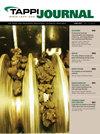所选口罩的过滤效率和透气性
IF 0.6
4区 农林科学
Q4 MATERIALS SCIENCE, PAPER & WOOD
引用次数: 0
摘要
多年来,口罩一直被用作阻止呼吸道感染的物理屏障。由于认证口罩供应不足,在2019冠状病毒病大流行期间,面罩、绑腿和可重复使用的织物口罩等替代面罩受到了关注。然而,为了让这些替代口罩发挥其预期功能,它们必须是有效的。此外,临时口罩提供的透气性必须达到一定水平。本文报道的工作是为了确定过滤效率(FE)、透气性和掩膜基质重要物理特性之间的关系。用扫描电镜测定了芯滤层的纤维直径。使用湿蒸汽透过率(MVTR)测试了五种口罩(两种N95口罩、两种外科口罩和100%针织棉织物)的FE和透气性。棉针织口罩FE最低(5.10% ~ 26.47%),美国职业安全卫生研究院(NIOSH)认证的N95口罩FE最高(92.10% ~ 99.65%)。但是,棉口罩在压降方面优于N95,这意味着更高的舒适度。总的来说,N95口罩对雾化颗粒的防护效果最好。回归分析表明,掩膜滤光片的纤维直径是掩膜滤光片等效系数的重要预测因子。本研究证实纤维直径与过滤能力成反比。结果表明,结构紧凑,纤维细,过滤效率高。这项研究有助于开发分层口罩,以获得最佳过滤器,具有良好的过滤效果,更适合佩戴者,并且可接受的舒适度。本文章由计算机程序翻译,如有差异,请以英文原文为准。
Filtration efficiency and breathability of selected face masks
Face masks have been used as physical barriers to stop respiratory infections for many years. Due to insufficient and low supply of certified masks, alternative face covers such as face shields, neck gaiters, and fabric reusable masks gained attention during the COVID-19 pandemic. However, for these alternate face masks to fulfill their intended function, they must be effective. Additionally, the level of breathability provided by the makeshift masks must be at a certain level. The work reported in this paper was carried out to determine the relationship between filtration efficiency (FE), breathability, and important physical characteristics of mask substrates. The fiber diameter of the core filter layer was determined using a scanning electron microscope. Five types of face masks (two types of N95, two types of surgical masks, and a 100% knitted cotton fabric) were tested for their FE and breathability using moisture vapor transmission rate (MVTR). The cotton knitted mask had the lowest FE (5.10%–26.47%), while the National Institute for Occupational Safety and Health (NIOSH)-certified N95 mask had the highest FE values (92.10%–99.65%). However, the cotton mask outperformed the N95 in terms of the pressure drop, meaning higher comfort. In general, the N95 face mask provided the best protection against aerosolized particles. According to the regression analysis, the fiber diameter of the mask filter substrate serves as an important predictor of FE of mask substrates. In this study, it was confirmed that fiber diameter is inversely related to the filtration ability. Results show that compact structure with finer fibers will enable higher filtration efficiency. The study lends itself to developing layered face masks to obtain optimum filters with good filtration, better fit, and acceptable comfort for the wearer.
求助全文
通过发布文献求助,成功后即可免费获取论文全文。
去求助
来源期刊

Tappi Journal
工程技术-材料科学:纸与木材
CiteScore
1.30
自引率
16.70%
发文量
59
审稿时长
6-12 weeks
期刊介绍:
An internationally recognized technical publication for over 60 years, TAPPI Journal (TJ) publishes the latest and most relevant research on the forest products and related industries. A stringent peer-review process and distinguished editorial board of academic and industry experts set TAPPI Journal apart as a reliable source for impactful basic and applied research and technical reviews.
Available at no charge to TAPPI members, each issue of TAPPI Journal features research in pulp, paper, packaging, tissue, nonwovens, converting, bioenergy, nanotechnology or other innovative cellulosic-based products and technologies. Publishing in TAPPI Journal delivers your research to a global audience of colleagues, peers and employers.
 求助内容:
求助内容: 应助结果提醒方式:
应助结果提醒方式:


